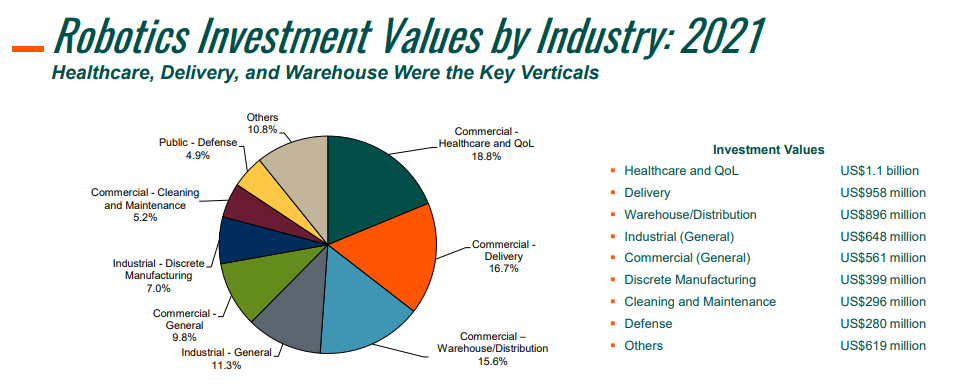The robotics industry is becoming more mature as companies aim to boost productivity in the workplace and make up for the shortcomings they face. Robotic deployments can automate labor-intensive, repetitive, and hazardous tasks to keep human workers fresh and healthy, while also speeding up the time it takes to accomplish those tasks. To stay informed, here are five trends that are dominating the robotics industry.
Get Updated Forecasts: The Global Robotics Market Outlook
Robotics Industry Growth
Before we begin, I'd like to briefly share ABI Research's broad overview of robotics investment.
Above all, the most striking trend in the robotics industry is the enormous amount of financial backing for robotic companies. ABI Research reports that total Venture Capitalist (VC) funding in the robotics industry jumped by 38% between 2021 and 2022—bringing the total investment to US$6.5 billion.
COVID-19 is a huge reason for the uptick in robotics investment as the pandemic has led to labor shortages, social distancing protocols, and supply chain constraints—leading companies down the path to automation.
When referring to robotics, there are six main categories that are included under this term:
- Industrial robots
- Collaborative Robots (cobots)
- Mobile robots
- Unmanned Aerial Vehicle (UAV) systems
- Consumer robots
- Exoskeletons
Robotics Industry Trend #1: The United States Receives the Most VC Funding
The majority of countries simply lack the money and other resources to develop a strong robotics startup landscape. As a result, we see the big markets leading the way in the robotics industry, including the United States, China, the United Kingdom, Israel, the European Union (EU), etc. Overall, the United States is far and away receiving the greatest amount of VC funding in the robotics industry, encompassing more than half of total investment in 2021.
The United States and China account for six out of the top ten most heavily funded startups in the world (four U.S. startups and two Chinese startups). Both countries have excelled at growing startups with a diverse set of competencies, such as last-mile delivery, indoor Autonomous Mobile Robots (AMRs), autonomous drones, and machine vision services.
| In 2025, robotics deployments have still struggled to scale and revolutionize manufacturing the way the industry originally hoped for. However, Artificial Intelligence (AI) software has emerged as a game-changer for robotics. Learn how AI is addressing the most pressing robotic challenges by reading our recent blog post, AI Meets Robotics: Why Closed-Loop Frameworks Are Key to Next-Gen Automation. |
Robotics Industry Trend #2: Healthcare Organizations Are Turning to Automation
Healthcare has proven to be an enormous vertical for robotics, as these technologies are used for patient monitoring, inventory tracking, automating routine tasks, cleaning and disinfection, and even helping assist with minimally invasive surgeries.
As pointed out in ABI Research’s Smart Technologies Revolutionizing the Home Healthcare Market blog post, a common trend in the robotics industry is the use of social robots to provide empathy and social interaction for elderly people.
Robots can also be used for putting objects away for the patient and sending health status updates to physicians remotely. In 2021, robotics investments in the healthcare vertical were north of US$1 billion.
Although healthcare saw the most investment in the robotics industry, the delivery and warehouse verticals aren’t too far behind. While the delivery vertical saw US$958 million in investment in 2021, the warehouse and distribution vertical generated US$896 million.
Chart 1: Investment in Robotics in 2021 by Industry
Robotics Industry Trend #3: Cobots Are Becoming More Advanced
Thanks to deep learning-based machine vision innovation, collaborative robots are incredibly accurate and precise. Additionally, deep learning and reinforcement learning algorithms enable cobots to function more dynamically. For example, the robot will make real-time motion adjustments when it’s necessary to do so.
Robots are also better equipped straight off the shelf these days, in the form of Robotics-as-a-Service (RaaS). It’s commonplace for robots to come pre-trained for specific use cases, eliminating the requirement for system integrators, programming skillsets, and extra hardware.
Robotics Industry Trend #4: California Is a Hotspot for Robotics Innovation
Although California has a huge influence in several robotics segments, drone services and last-mile delivery were two verticals that really stuck out in 2021.
California Startups in Drone-Related Services
DroneBase, Shield AI, and Zipline are just three of many California-based drone services companies that have received a significant amount of financial backing recently. DroneBase provides an aerial data analytics platform that allows companies to monitor assets, plan for maintenance, and understand site conditions. In 2021, DroneBase raised US$32.5 million in Series C funding.
Shield AI focuses on military and civilian defense using its dynamic UAV solutions. With the company’s Hivemind software, the UAVs can fly without the need for a Global Positioning System (GPS), communications, or even a remote pilot. The learning algorithms that Shield AI UAVs come packed with allow the autonomous aircraft to decide what the best strategies are when operating. Besides raising US$280 million in funding, Shield AI has also made two recent acquisitions: Martin UAV and Heron Systems.
Zipline offers UAVs for the healthcare and retail industries and raised US$250 million in Series E funding in 2021. Much of the company’s focus is on Africa where its drone services are used to distribute medical supplies to impoverished regions. For example, the country of Ghana used Zipline for COVID-19 vaccination distribution in November 2021.
California Startups in Last-Mile Delivery Robotics
Besides the drones segment, California has numerous startups working on last-mile delivery robots. Coco, Nuro, and Starship Technologies are three promising startups based out of California developing autonomous delivery solutions. In addition to making deliveries to residences via sidewalk and to students on college campuses, big-name companies like Domino’s and FedEx have shown great interest in these types of technologies. Collectively, these three California-based startups raised US$653 million in funding in 2021, with Nuro receiving US$600 million alone.
You May Also Like:
What Is Simultaneous Localization Mapping (SLAM) and How Is It Used?
Leveraging Robotics Simulation for Safer, More Efficient Deployments
Robotics Industry Trend #5: Acquisitions Run Rampant
As established brands want to expand their robotics product portfolios, industry acquisitions have been par for the course. ABB is an early mover among big-name industrial robot vendors when it comes to Autonomous Guided Vehicles (AGVs) and AMRs as the company bought out ASTI, a company that has more than 4,500 AMR deployments.
JASCI, a company that develops Warehouse Management Systems (WMSs), recently acquired NextShift Robotics. These robots are equipped with a conveyor to pick up totes and also transport the totes over to a selected workstation. A solution like this saves human workers a great amount of time and energy going back and forth with totes all day.
In 2017, SoftBank purchased Boston Dynamics from Alphabet for about US$1 million. However, that valuation skyrocketed to US$1.1 billion in 2021, when SoftBank came to an acquisition agreement in which Hyundai Motor Group took over. Hyundai Motor Group views the addition of Boston Dynamics as a stepping-stone to greater things in the following spaces: autonomous cars, logistics, construction, manufacturing, and urban air mobility.
Using Robotics Industry Trends to Plan Ahead
The robotics industry is changing before our eyes and if we don’t stop and look at some of the key trends shaping these exciting technologies, we just may miss out on lucrative business opportunities. Whether a new robotics vendor wants to see what other startups are up to or if a C-suite yearns to learn more about the current industry landscape, these five trends serve as the first step to a new journey.
To get the full breakdown of the robotics industry, including VC funding behavior, robotics use cases, regional comparisons, key players, and more, download ABI Research’s Robotics Investment Monitor 2021 presentation file. This content comes from the company’s Industrial, Collaborative & Commercial Robotics Research Service.


